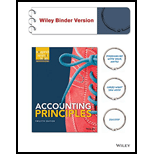
Concept explainers
Internal Control:
Internal control can be defined as a process to ensure achievement of the objectives of an organization in operational effectiveness and efficiency, reliable financial reporting, and compliance with laws, regulations and policies. The internal controls are framed in an organization to eliminate the internal control deficiencies of the organization.
Procedure for debiting and crediting an account:
- Increase in assets account, increase in expenses account, and decrease in liabilities account should be debited.
- Decrease in assets account, increase in revenue account, and increase in liabilities account should be credited.
All transactions affect the
To record: The journal entries for transaction (a) and transaction (b).
Want to see the full answer?
Check out a sample textbook solution
Chapter 8 Solutions
Accounting Principles 12E WileyPLUS with Loose-Leaf Print Companion with WileyPLUS Leanring Space Card Set
- Please provide the solution to this general accounting question with accurate financial calculations.arrow_forwardComputer Haven sells laptops. During June 2021, it sold 320 laptops at a $1,650 average price each. The June 2021 budget included sales of 350 laptops at an average price of $1,550 each. Compute the sales price variance and the sales volume variance for June 2021.arrow_forwardWhat are the total product cost for the company?arrow_forward
- Hardy Technologies reports that at an activity level of 6,800 machine-hours in a month, its total variable inspection cost is $320,000 and its total fixed inspection cost is $150,000. What would be the average fixed inspection cost per unit at an activity level of 7,100 machine-hours in a month? Assume that this level of activity is within the relevant range.arrow_forwardCan you explain this general accounting question using accurate calculation methods?arrow_forwardI need help with question is correct answer and accountingarrow_forward
- What is the total cost of job number D5673?arrow_forwardNeed help answering question B? Negus Enterprises has an inventory conversion period of 55 days, an average collection period of 42 days, and a payables deferral period of 20 days. Assume that cost of goods sold is 80% of sales. Assume a 365-day year. Do not round intermediate calculations. A. What is the length of the firm's cash conversion cycle? Round your answer to the nearest whole number. 77 days B. If annual sales are $4,635,500 and all sales are on credit, what is the firm's investment in accounts receivable? Round your answer to the nearest dollar. $ C.) How many times per year does Negus Enterprises turn over its inventory? Round your answer to two decimal places. 6.64arrow_forwardI need the correct answer to this general accounting problem using the standard accounting approach.arrow_forward

 AccountingAccountingISBN:9781337272094Author:WARREN, Carl S., Reeve, James M., Duchac, Jonathan E.Publisher:Cengage Learning,
AccountingAccountingISBN:9781337272094Author:WARREN, Carl S., Reeve, James M., Duchac, Jonathan E.Publisher:Cengage Learning, Accounting Information SystemsAccountingISBN:9781337619202Author:Hall, James A.Publisher:Cengage Learning,
Accounting Information SystemsAccountingISBN:9781337619202Author:Hall, James A.Publisher:Cengage Learning, Horngren's Cost Accounting: A Managerial Emphasis...AccountingISBN:9780134475585Author:Srikant M. Datar, Madhav V. RajanPublisher:PEARSON
Horngren's Cost Accounting: A Managerial Emphasis...AccountingISBN:9780134475585Author:Srikant M. Datar, Madhav V. RajanPublisher:PEARSON Intermediate AccountingAccountingISBN:9781259722660Author:J. David Spiceland, Mark W. Nelson, Wayne M ThomasPublisher:McGraw-Hill Education
Intermediate AccountingAccountingISBN:9781259722660Author:J. David Spiceland, Mark W. Nelson, Wayne M ThomasPublisher:McGraw-Hill Education Financial and Managerial AccountingAccountingISBN:9781259726705Author:John J Wild, Ken W. Shaw, Barbara Chiappetta Fundamental Accounting PrinciplesPublisher:McGraw-Hill Education
Financial and Managerial AccountingAccountingISBN:9781259726705Author:John J Wild, Ken W. Shaw, Barbara Chiappetta Fundamental Accounting PrinciplesPublisher:McGraw-Hill Education





